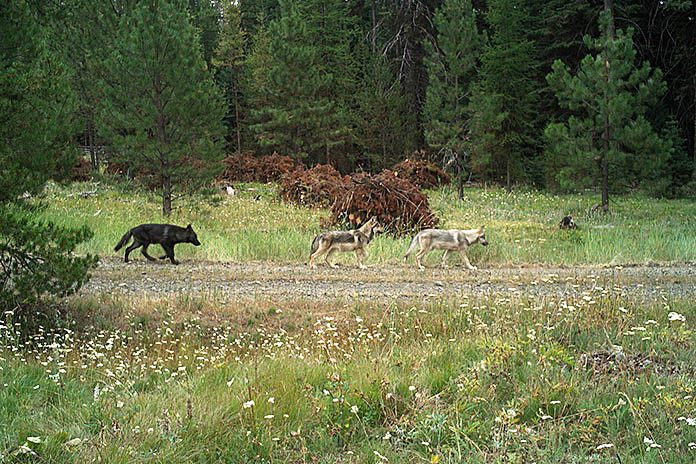
State wildlife biologists counted 158 wolves in Oregon this past winter, a 15 percent increase over last year’s count of 137, according to the Oregon Wolf Conservation and Management 2019 Annual Report released Wednesday at odfw.com/wolves.
This annual count is based on verified wolf evidence (like visual observations, tracks, and remote camera photographs) and is considered the minimum known wolf count, not an estimate of how many wolves are in Oregon. The actual number of wolves in Oregon is likely higher, as not all individuals present in the state are located during the winter count.
A total of 22 packs were documented during the count, up from 16 packs in 2018. (A pack is defined as four or more wolves traveling together in winter.) Nine other groups of 2-3 wolves were also identified. Nineteen of Oregon’s wolf packs successfully reproduced and had at least two adults and two pups that survived through the end of 2019, making them “breeding pairs,” a 27 percent increase over last year’s number.
“The state’s wolf population continues to grow and expand its range, with three new packs in the Blue Mountains south of Interstate 84,” said Oregon Department of Fish & Wildlife Wolf Coordinator Roblyn Brown.
Highlights from the report:
OR7, the breeding male of the Rogue Pack, was photographed in the fall but was not documented during the winter count, though his mate is still present in the pack area with three wolves. No reproduction for the pack was documented during 2019. OR7 is estimated to be 11 years old (born in 2009). “We don’t know if OR7 has died, but it would be reasonable to assume considering his age, which is old for a wolf in the wild,” said Brown. “It is natural for packs to change over time as individual wolves are born, disperse or die.”
A new breeding pair, the Indigo Pack, was confirmed in eastern Lane and Douglas Counties bringing the total number of packs in western Oregon to three.
Eight new packs were designated, and all are breeding pairs: Bear Creek, Clark Creek, Cornucopia, Desolation, Fivemile, Heppner, Indigo and Keating. Three packs that previously qualified as packs, no longer have four individuals (Snake River, South Snake, and Wildcat).
Seven wolf mortalities were documented during the year, including one of disease and five wolves struck by vehicles. In March, a livestock producer in Baker County lawfully shot one of four wolves that was chasing his herding dog close to his house. (Under Wolf Plan rules, livestock producers may shoot a wolf “caught in the act” of chasing livestock or livestock working dogs.) No cases of unlawful wolf killing were documented in 2019, and a case from 2016 involving the shooting death of OR28 in Lake County was resolved with a guilty plea.
Biologists documented 15,716 wolf location data points by radio collar or other methods including remote camera surveillance and aerial, track and howling surveys. Of those, 71 percent of locations for resident wolves were on public lands, 26 percent on private lands, and 3 percent on tribal lands.
ODFW confirmed 16 wolf depredations of livestock, down 43 percent from the 28 confirmed last year. Confirmed losses (livestock killed or euthanized) in 2019 were one adult cow, one steer, 11 calves, six sheep, and one livestock protection dog. In addition to the confirmed losses, one calf was confirmed injured by wolves.
Less than 30 percent of packs that were present in 2019 depredated on livestock. Five packs each depredated one time, and one pack depredated twice. The majority of Oregon’s wolf depredation was attributed to the Rogue Pack, which depredated nine times in 2019.
Depredation in the portion of Oregon that ODFW manages (east of the Highways 395-78-95 boundary) did not meet a level where lethal removal was requested or authorized. No wolves were lethally removed by ODFW in 2019 for chronic depredation.








